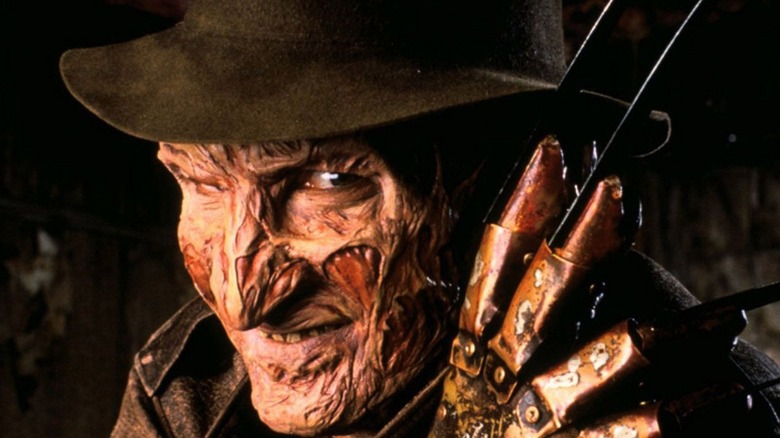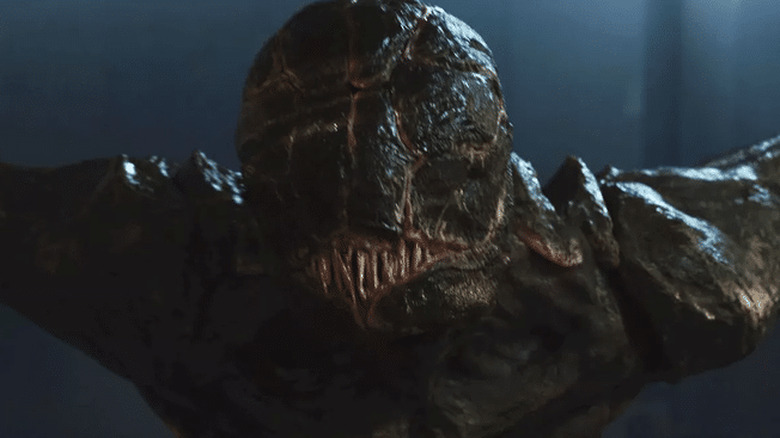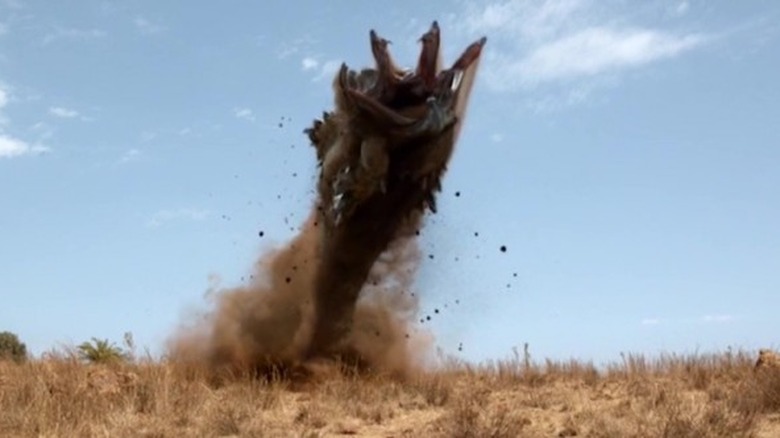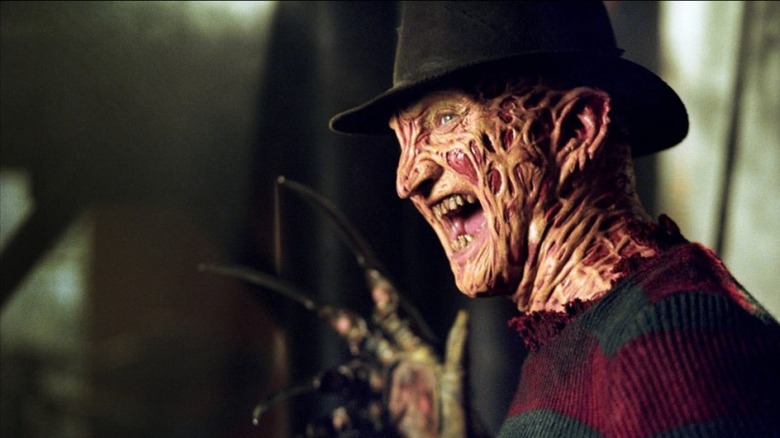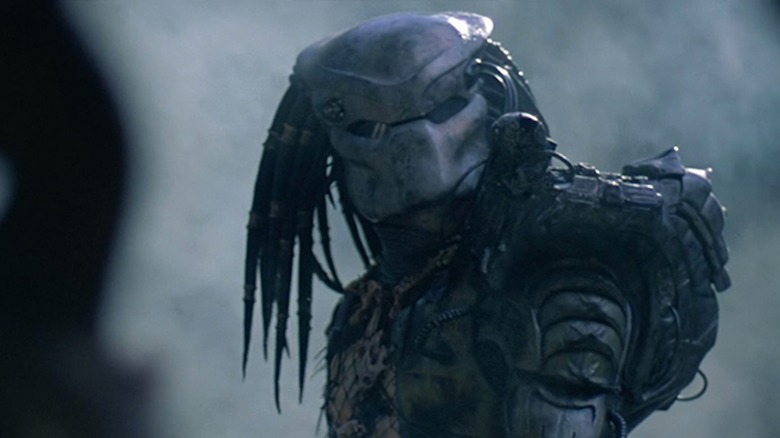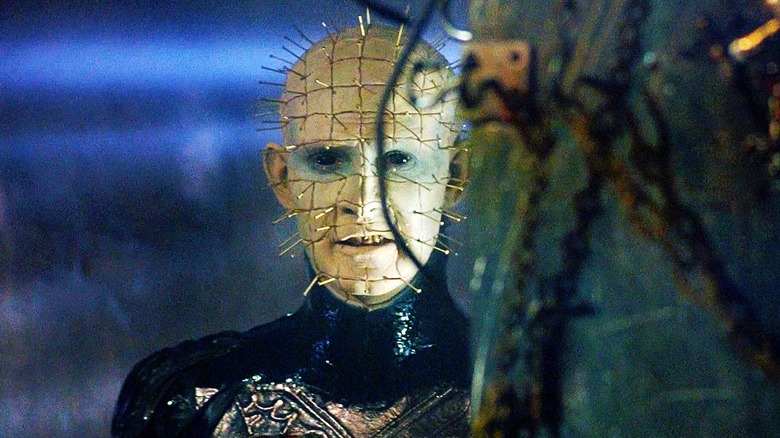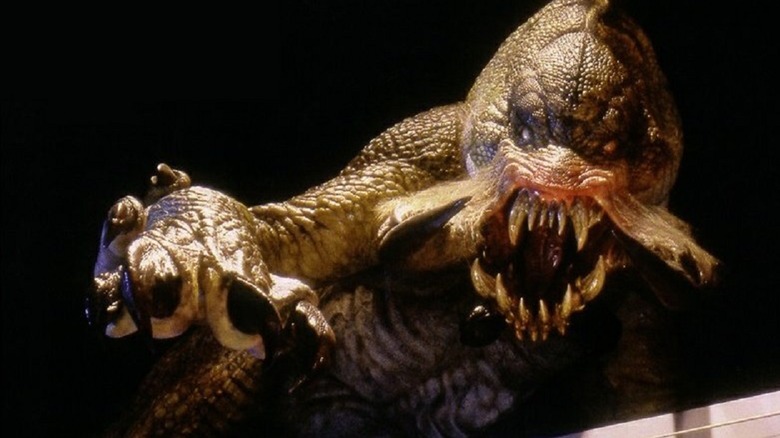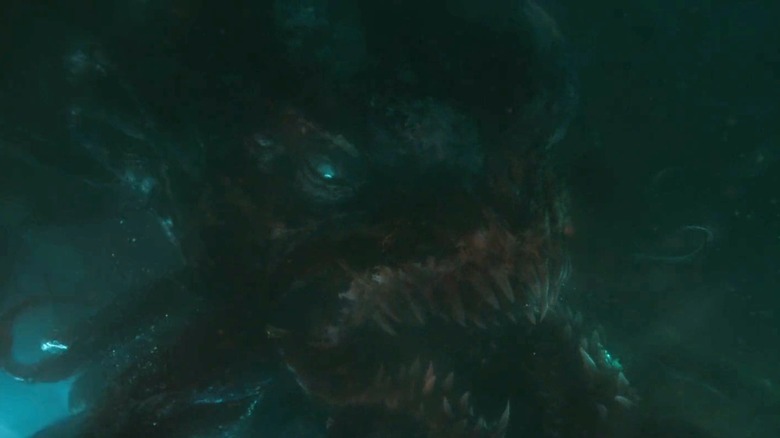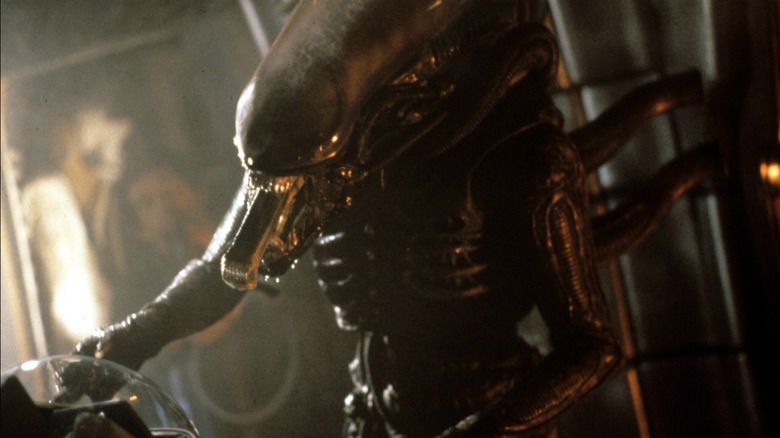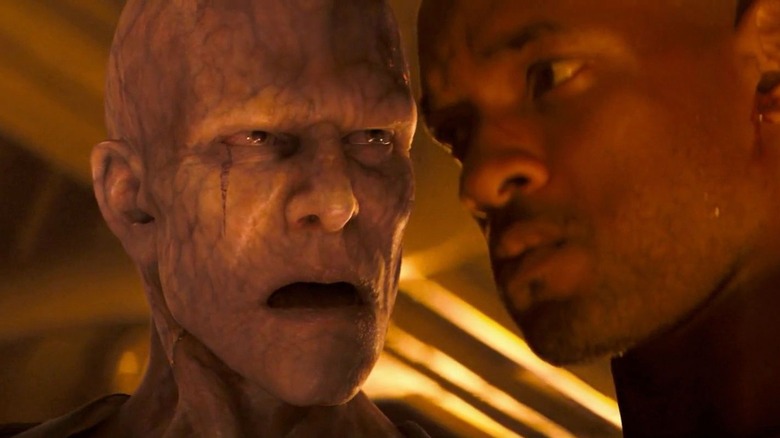Horror Movie Monsters That Could Have Looked Completely Different
Dr. Viktor Frankenstein is the fictional keystone for generations of horror artists. Monster makers bring dreams and nightmares to life, realizing a filmmaker's vision for the impossible things we need to see and shudder at. While movie monsters existed long before Bela Lugosi put on Dracula's cape in 1931, the birth of the classic Universal Monsters franchise is hard to ignore as a watershed moment for things that go bump in the night. Since then, artists like Ray Harryhausen, Phil Tippett, Stan Winston, and countless more have grown with the technology used to evolve an idea from the drawing board to the cinema screen.
However, making these critters isn't always a clear-cut process. Growing an idea into something we can shudder at can take a few attempts to get terrifying right. Sometimes, even the things that go bump in the night had their awkward teenage years. Below, find out about some of the alternate designs for some famous movie monsters.
A Quiet Place
The murderous creatures of "A Quiet Place" never had an official name. A news clipping seen in the original film calls them Death Angels, and their arrival in the opening minutes of the sequel justifies it. That's good enough to give them a unique heading on movie monster wikis. Their appearance is definitely unearthly; long, leathery limbs and a head that unfurls into toothy nightmare. But their inspiration is all natural, including prehistoric fish and the wasted appearance of mummified bog men. Their only weakness is a specific band of sound, and it's a good thing that gets figured out before John Krasinski's grieving family is wiped out.
The original concept for the Death Angels didn't emerge until the film came to home media, and they're definitely a twist on the final result. The first primitive inspirations for these alien invaders were still fish, yes, but bony, nautiloid shellfish instead of the organic shape we got. The early CGI roughs look more like a concept for a Decepticon from Michael Bay's "Transformers" franchise, spindly and cruel, with horns jutting out of their brows. It's a harsher look, but also somehow boring and familiar, like something Vin Diesel would fight. Krasinski, who also motion-capped for these CGI beasties, was fascinated by the way the final designs abruptly evolved into today's "death angel" baddies, and it's not hard to understand why.
Tremors 5
How does a straight to streaming franchise movie five levels deep rate a place on this list? Because the loss of the original creators in favor of cost cutting, profit-boosting tactics means those cuddly ol' Graboids were abruptly replaced with a bizarre CGI "subspecies." Universal's demands for "Tremors 5" included heavy control and a shrunken budget, after which point Stampede, the original production crew, bowed out. The reworked script introduced a new threat based on African termites, replacing the pudgy, vaguely Shai-Hulud-like graboids of old.
Already under fire for terrible CGI in the third "Tremors" film, production ensured that the quality of the critter effects did improve. Other graboid subspecies, like the Assblaster, underwent significant changes to update them, and totally coincidentally, move them further away from concepts originated by the franchise creators. The results? Not only are these busy little creeps not the graboids we all grew up with, but the fan community's suffered a heavy schism ever since. The original creators continue to talk with fans about what could have been, and discuss their own ideas for changed-up subspecies on their production site.
A Nightmare on Elm Street
Wes Craven's Freddy Krueger (played by Robert Englund), first seen in "A Nightmare on Elm Street" in 1984, is a hall of famer for modern movie monsters. In life, he was a serial child killer, preferring to slash his victims up with the bladed glove he'd crafted. Set on fire by furious parents, he lives on in nightmares (and a never-ending franchise gig), bearing hideous third degree burns and the ruins of the sweater he died in. He's a slasher icon, unmistakable in his visage.
However, early concept art shows how Freddy could have been a very different dude. In 2015, Bloody Disgusting earned a glimpse at some early process photos from Freddy's makeup and couture guy, David B. Miller. These rare photos show a sleeveless sweater and a pageboy cap, instead of that famous fedora. Weirdest of all is a much smoother makeup job that looks more like a severe case of teenage acne than the results of a Molotov cocktail party. Yikes! Glad we missed that. The real hero of the hour, according to Miller? A jolt of inspiration from pepperoni pizza.
Predator
The evolution of the man-hunting Yautja is something hardcore fans of the elite Predator never take for granted, especially after whatever the hell that was in "Aliens Vs. Predator: Requiem." But it's the behind the scenes origin story from 1987's "Predator" that truly makes us thankful for the lizard-like horror under that sleek steel mask. Most fans know that there were a few hitches early in filming, thanks to a mismatch between the small and agile Jean-Claude Van Damme in a monster suit versus a half a dozen giant meat men.
That story hides some big facts, like a half-year filming delay too allow the Predator to be completely redesigned. The original version, from Boss Film, looked more like an "Ultraman" man-in-suit kaiju, with an elongated, ant-like face and spindly legs that often required harness rigging. Van Damme often wore a red chroma suit version while filming action sequences, so the finished model could be composited in later. The results were not up to director John McTiernan's standards, and Van Damme left production along with the original "Boss" predator. Stan Winston got a last minute call, and the rest history.
Hellraiser
While Clive Barker's early sketches of Pinhead the Hell Priest (Doug Bradley) ultimately come through in the final version, there are enough fine details changed that they would have made for a different Cenobite in tone. Drawing inspiration from an unused scene Barker did for 1985's "Underworld" and a geometric nail board that featured in Barker's experimental short film "The Forbidden," those early sketches feature a figure less like a regal priest and more a primal shaman.
The image of a straggly, long-haired figure is still pierced throughout, and even a later sketch that resembles the villain from "The Midnight Meat Train" keeps the brutality as a running theme. But a bloody apron and other visual cues suggest a harder, grimmer figure would have arisen from wearing the costume on set. It's a change that might still have worked for the franchise in the long run, but the cold beauty and honor of Pinhead is something still so perfect today that it's hard to imagine his alternate self being as immortal.
The Relic
Douglas Preston and Lincoln Child's "The Relic" is a long-running New York Times best-selling series about an eccentric FBI agent named Aloysius Pendergast. This is the only film to adapt one of those stories, and their central character is subsumed into an only slightly eccentric and easier to pronounce cop named Vincent D'Agosta (Tom Sizemore). What's more, a well-researched critter that lurched from the depths of the Amazon is changed into a basic Hollywood monster, a far cry from Mbwun, the unearthly blend of gecko and tiger that tormented the Natural History Museum.
The 1997 movie's version is called Kothoga, and the final result mostly ignores the wonderful early sketches by "Jurassic Park" artist Mark 'Crash' McCreery, which hew pretty close to Preston & Child's description. McCreery brings his dinosaur expertise to the fore, adding powerful legs that could launch the beast into a terrifying lunge. Instead, a mostly boar-like creature with a lizard tail and absurd horns take the stage. What they lose is something that could have visually connected to the prehistory of our world, another, grimmer play on bringing back long-dead species in the modern era.
Underwater
The Lovecraftian elements of 2020's "Underwater" worked their way deep into this underrated Kristen Stewart horror vehicle by the time it hit theaters, but that didn't happen overnight. Early concept art shows that the production didn't start out committed to sneaking in that big Dread Cthulhu Wakes finale. Instead, it tiptoes around the legacy and nature of its deep world bestiary, scratching together lesser horrors that mostly resemble a Maryland big catch gone bad.
The human Dagon-style worshippers don't come in until director Willam Eubank had committed to his homage to the horror legend. Instead, they're far more crablike, maybe even ticklike, with spiky shells, mandibles, and far too many legs to be entirely natural. At this stage, they were simply called 'Clingers,' and frankly, they just don't do it for us. The final design, which links the subtle revelation that the corporation Stewart works for wanted this to happen with Lovecraft's "A Shadow over Innsmouth," is a far more effective result.
Alien
It's not clear how serious writer Dan O'Bannon intended his early concepts for the Xenomorph from 1979's "Alien" and its face-hugger embryo stage to be taken, but the latter is oddly hilarious, nonetheless. The former is still pretty chilling in concept art form, though it goes through the usual insectoid-equals-unsettling phase of alien design. There's a few oddly avian aspects to the design, including wobbly, webbed legs. It's the head that draws our attention the strongest, however. Strange, sharp mandibles replace the elongated jaw that we know, but the egg-like head and empty eyes still manage to create an eerie effect. On set, there's no way this poor misshapen critter could've worked as an effective threat. It might even have walked like E.T.
Meanwhile, O'Bannon's embryo sketch is just funny. It's actually less a concept piece and more a note to H.R. Giger on how he and Scott would like this stage of the Xenomorph to behave. It features a simplistic, Playskool-style egg and a horrible (hilarious) little face bouncing out to chase its victim. No, it wouldn't have worked for Ridley Scott's "Alien," but if O'Bannon ever worked with John Carpenter on a "Dark Star 2," he's got one hell of a sketch kit ready to go.
I Am Legend
It's easy to rip on CGI for failing to deliver on its visual promise, especially when you consider how poorly it can age a film as compared to practical effects. Movies like 2007's "I Am Legend" do not help the arguments in favor of CGI, providing some of the worst-case scenarios for filmmakers to look back and cringe upon. Ironically, the earliest and potentially best concept art for Will Smith's quasi vampire-hunting adventure came from a failed production once led by Ridley Scott.
Scott abandoned the project back in 1997, had Schwarzenegger in mind for his lead. But what's truly fascinating is the early makeup concept for the evolving vampires of Richard Matheson's imagination. Scott's imagination went to wax figures, and his design team provided a test shot of a thinning, almost translucent-skinned man with piercing eyes. Not only does this single shot look more vibrant and alive than the Darkseekers that Smith faces, but it's almost empathetic enough to ensure that the story's original twist ending — Smith is the real monster, here — would have stuck the landing. So much for what could have been, and sadly, in this case, what we got was so much worse.
